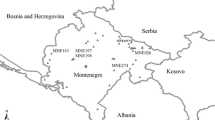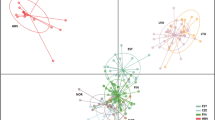Abstract
The Genebank at the Leibniz Institute of Plant Genetics and Crop Plant Research (IPK) harbours three different potato collections comprising 2846 wild potato accessions, 2757 accessions of cultivars, landraces and breeding material of Solanum tuberosum L. and 579 Solanum clones originating mainly from South and Central America (as of July 2016). The three collections are maintained via seeds, in vitro culture, cryopreservation or in the field. All four processes are labour and cost intensive. Therefore, methods facilitating the efficient management and maintenance of the collections are needed. We describe the experimental application of the retrotransposon-based Inter-SINE amplified polymorphism (ISAP) marker system for supporting the management of potato collections. Three ISAP primer combinations were evaluated on a set of 259 cultivated and 89 wild potato accessions focussing on three different aspects: diversity analysis, duplicate identification and phylogenetic studies. Compared to up to 29 microsatellites, ISAPs were similarly efficient in monitoring genetic diversity and detecting duplicated accessions. In addition, the three ISAP primer combinations could be applied to wild potato species, although their use in phylogenetic studies is limited due to their highly polymorphic nature. Generally, ISAPs are a very valuable tool in the maintenance of clonally maintained potato collections and for the verification of the identity of accessions.




Similar content being viewed by others
References
Ames M, Spooner DM (2008) DNA from herbarium specimens settles a controversy about origins of the European potato. Am J Bot 95(2):252–257
Bajaj YPS (1981) Regeneration of plants from potato meristems freeze-preserved for 24 months. Euphytica 30:141–145
Cooper HD, Spillane C, Hodgkin T (2001) Broadening the genetic base of crops: an overview. In: Cooper HD, Spillane C, Hodgkin T (eds) Broadening the genetic base of crop production, CABI, Wallingford, pp 1–24
Deragon J-M, Zhang X (2006) Short Interspersed elements (SINEs) in plants: origin, classification, and use as phylogenetic markers. Syst Biol 55(6):949–956
Doyle JJ, Doyle JL (1990) Isolation of plant DNA from fresh tissue. Focus 12:13–15
FAO (2014) Genebank standards for plant genetic resources for food and agriculture, Rev. edn. FAO, Rome
Feingold S, Lloyd J, Norero N, Bonierbale M, Lorenzen J (2005) Mapping and characterization of new EST-derived microsatellites for potato (Solanum tuberosum L.). Theor Appl Genet 111:456–466
Ghislain M, Rodríguez F, Villamón F, Núñez J, Vásquez C, Waugh R, Bonierbale M (2004) Selection of highly informative and user-friendly microsatellites (SSRs) for genotyping of cultivated potato. Theor Appl Genet 108:881–890
Ghislain M, Andrade D, Rodríguez F, Hijmans RJ, Spooner DM (2006) Genetic analysis of the cultivated potato Solanum tuberosum L. Phureja Group using RAPDs and nuclear SSRs. Theor Appl Genet 113:1515–1527
Ghislain M, Núñez J, del Rosario Herrera M, Pignataro J, Guzman F, Bonierbale M, Spooner DM (2009) Robust and highly informative microsatellite-based genetic identity kit for potato. Mol Breed 23:377–388. doi:10.1007/s11032-008-9240-0
Hardigan MA, Bamberg J, Buell CR, Douches DS (2015) Taxonomy and genetic differentiation among wild and cultivated germplasm of Solanum sect. Petota. Plant Genome 8(1):1–16
Hawkes JG (1990) The potato. Evolution, biodiversity and genetic resources. Belhaven Press, Oxford
Huamán Z, Hoekstra R, Bamberg JB (2000) The inter-genebank potato database and the dimensions of available wild potato germplasm. Am J Potato Res 77:353–362
Jacobs MMJ, van den Berg RG, Vleeshouwers VGAA, Visser M, Mank R, Sengers M, Hoekstra R, Vosman B (2008) AFLP analysis reveals a lack of phylogenetic structure within Solanum section Petota. BMC Evol Biol 8:145–157. doi:10.1186/1471-2148-8-145
Jacobs MMJ, Smulders MJM, van den Berg RG, Vosman B (2011) What’s in a name; Genetic structure in Solanum section Petota studied using population-genetic tools. BMC Evol Biol 11:42. doi:10.1186/1471-2148-11-42
Kalendar R, Grob T, Regina M, Suoniemi A, Schulman A (1999) IRAP and REMAP: two new retrotransposon-based DNA fingerprinting techniques. Theor Appl Genet 98:704–711
Keller ERJ, Senula A, Grübe M, Diekmann K, Dehmer KJ (2014) Fifteen years of cryopreservation in the IPK Genebank—experience, conclusions and outlook. In: Reed BM (ed) Proceedings of the 2nd international symposium on plant cryopreservation: Fort Collins, Colorado, USA, August 11–14, 2013 (Series: Acta Horticulturae, vol 1039). ISHS, Leuven, pp 249–263
Milbourne D, Meyer RC, Collins AJ, Ramsay LD, Gebhardt C, Waugh R (1998) Isolation, characterisation and mapping of simple sequence repeat loci in potato. Mol Gen Genet 259(3):233–245
Ovchinnikova A, Krylova E, Gavrilenko T, Smekalova T, Zhuk M, Knapp S, Spooner DM (2011) Taxonomy of cultivated potatoes (Solanum section Petota: Solanaceae). Bot J Linn Soc 165:107–155
Reid A, Kerr EM (2007) A rapid simple sequence repeat (SSR)-based identification method for potato cultivars. Plant Genet Res 5(1):7–13. doi:10.1017/S1479262107192133
Reid A, Hof L, Esselink D, Vosman B (2008) Potato cultivar genome analysis. In: Burns R (ed) Methods in molecular biology, plant pathology, vol 508. Humana Press, New York. doi:10.1007/978-1-59745-062-1_23
Reid A, Hof L, Felix G (2011) Construction of an integrated microsatellite and key morphological characteristic database of potato varieties on the EU Common Catalogue. Euphytica. doi:10.1007/s10681-011-0462-6
Seibt KM, Wenke T, Wollrab C, Junghans H, Muders K, Dehmer KJ, Diekmann K, Schmidt T (2012) Development and application of SINE-based markers for genotyping of potato varieties. Theor Appl Genet 125(1):185–196
Seibt KM, Wenke T, Muders K, Truberg B, Schmidt T (2016) Short interspersed nuclear elements (SINEs) are abundant in Solanaceae and have a family-specific impact on gene structure and genome organization. Plant J. doi:10.1111/tpj.13170
Sharma V, Nandineni MR (2014) Assessment of genetic diversity among Indian potato (Solanum tuberosum L.) collection using microsatellite and retrotransposon based marker systems. Mol Phylogenet Evol 73:10–17. doi:10.1016/j.ympev.2014.01.003
Shedlock AM, Okade N (2000) SINE insertions: powerful tools for molecular systematics. BioEssays 22:148–160
Solano J, Mathias M, Esnault F, Brabant P (2013) Genetic diversity among native varieties and commercial cultivars of Solanum tuberosum ssp. tuberosum L. present in Chile. Electron J Biotechnol. doi:10.2225/vol16-issue6-fulltext-15
Spooner DM, Castillo R (1997) Reexamination of series relationships of South American wild potatoes (Solanaceae: Solanum sect. Petota): evidence from chloroplast DNA restriction site variation. Am J Bot 84(5):671–685
Spooner DM, McLean K, Ramsay G, Waugh R, Bryan GJ (2005) A single domestication for potato based on multilocus amplified fragment length polymorphism genotyping. Proc Natl Acad Sci 102(41):14694–14699
Spooner DM, Ghislain M, Simon R, Jansky SH, Gavrilenko T (2014) Systematics, diversity, genetics, and evolution of wild and cultivated potatoes. Bot Rev 80:283–383
Van den Berg RG, Jacobs MMJ (2007) Molecular taxonomy. In: Vreugdenhil D, Bradshaw J, Gebhardt C, Govers F, MacKerron DKL, Taylor MA, Ross HA (eds) Potato biology and biotechnology—advances and perspectives. Elsevier, Amsterdam, pp 55–76
Van Eck HJ, Jacobs JME, van den Berg PMMM, Stiekema WJ, Jacobsen E (1994) The inheritance of anthocyanin pigmentation in potato (Solanum tuberosum) and mapping of tuber skin colour loci using RFLPs. Heredity 76:410–421
Volkov RA, Zanke C, Panchuk II, Hemleben V (2001) Molecular evolution of 5S rDNA of Solanum species (sect. Petota): application for molecular phylogeny and breeding. Theor Appl Genet 103:1273–1282
Volkov RA, Komarova NY, Panchuk II, Hemleben V (2003) Molecular evolution of rDNA external transcribed spacer and phylogeny of sect. Petota (genus Solanum). Mol Phyl Evol 29:187–202
Wenke T, Döbel T, Sörensen TR, Junghans H, Weisshaar B, Schmidt T (2011) Targeted identification of short interspersed nuclear element families shows their widespread existence and extreme heterogeneity in plant genomes. Plant Cell. doi:10.1105/tpc.111.088682
Wenke T, Seibt KM, Döbel T, Muders K, Schmidt T (2015) Inter-SINE amplified polymorphism (ISAP) for rapid and robust plant genotyping. In: Batley J (ed) Plant genotyping methods and protocols. Methods in molecular biology, vol 1245. Springer, New York, pp 183–192
Acknowledgements
We gratefully acknowledge the German Federal Ministry of Education and Research for funding this project (KMU-Innovativ, Grants Nos. 0315425 and 0315864).
Author contributions
KD carried out the ISAP and SSR marker analyses at IPK and drafted the manuscript. KMS optimized and adjusted the ISAP marker system. KM carried out the ISAP marker analyses at NORIKA. TW developed the ISAP marker system. HJ conceived the project and coordinated it. TS conceived the project and coordinated the ISAP marker development at TUD. KJD conceived and coordinated the study at IPK. All authors read and approved the final manuscript.
Author information
Authors and Affiliations
Corresponding author
Ethics declarations
Conflict of interest
The authors declare that they have no conflict of interests.
Electronic supplementary material
Below is the link to the electronic supplementary material.
10722_2016_484_MOESM1_ESM.pdf
Online Resource 1: Overview of the accessions used for the diversity and duplicate (bold) analyses; accessions written in italics were used in both studies. (PDF 164 kb)
10722_2016_484_MOESM2_ESM.pdf
Online Resource 2: Overview of the wild potato accessions used for the taxonomic analyses. Only one genotype of GLKS 30733, GLKS 32370 but three of GLKS 30716 were analysed. (PDF 114 kb)
10722_2016_484_MOESM3_ESM.pdf
Online Resource 3: Overview of the microsatellite markers used in this study, their amplicon lengths, concentration in the reaction, annealing temperatures (Ta in °C), original sources and how they were multiplexed. For the diversity analysis all multiplexes were used, for the duplicate study only multiplexes 1, 2 and 9 (PDF 94 kb)
Rights and permissions
About this article
Cite this article
Diekmann, K., Seibt, K.M., Muders, K. et al. Diversity studies in genetic resources of Solanum spp. (section Petota) by comparative application of ISAP markers. Genet Resour Crop Evol 64, 1937–1953 (2017). https://doi.org/10.1007/s10722-016-0484-y
Received:
Accepted:
Published:
Issue Date:
DOI: https://doi.org/10.1007/s10722-016-0484-y




